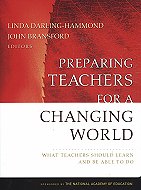|
Preparing Teachers for a Changing World: What Teachers Should Learn and be Able to Do
|
|
Linda Darling-Hammond, John Bransford (Eds.)
|

|

The Professions of law, medicine, engineering and architecture have put in place the key elements of a professional education curriculum - the building blocks that form the foundation of preparation for all those who enter these occupations. Only in recent years has the teaching profession begun to identify and develop the knowledge base that will frame its core curriculum.
Based on rapid advances in what is known about how people learn and how to teach effectively, this important book examines the core concepts and central pedagogies that should be at the heart of any teacher education program. Stemming from the results of a commission sponsored by the National Academy of Education, Preparing Teachers for a Changing World recommends the creation of an informed teacher education curriculum with the common elements that represent state-of-the-art standards for the profession.
Written for teacher educators in both traditional and alternative programs, university and school system leaders, teachers, staff development professionals, researchers, and educational policymakers, this book addresses the key foundational knowledge for teaching and discusses how to implement that knowledge within the classroom. Preparing Teachers for a Changing World recommends that, in addition to strong subject matter knowledge, all new teachers have a basic understanding of how people learn and develop, as well as how children acquire and us language, which is the currency of education. In addition, the book suggests that teaching professionals must be able to apply that knowledge in developing curriculum that attends to students' needs, the demands of the content, and the social purposes of education: in teaching specific subject matter to diverse students, in managing the classroom, assessing student performance, and using technology in the classroom.
The ideas and suggestions outlined in this book have far-reaching implications for educational policy, classroom practice, and staff development and will go a long way toward informing the next generation of teachers.
|
|
